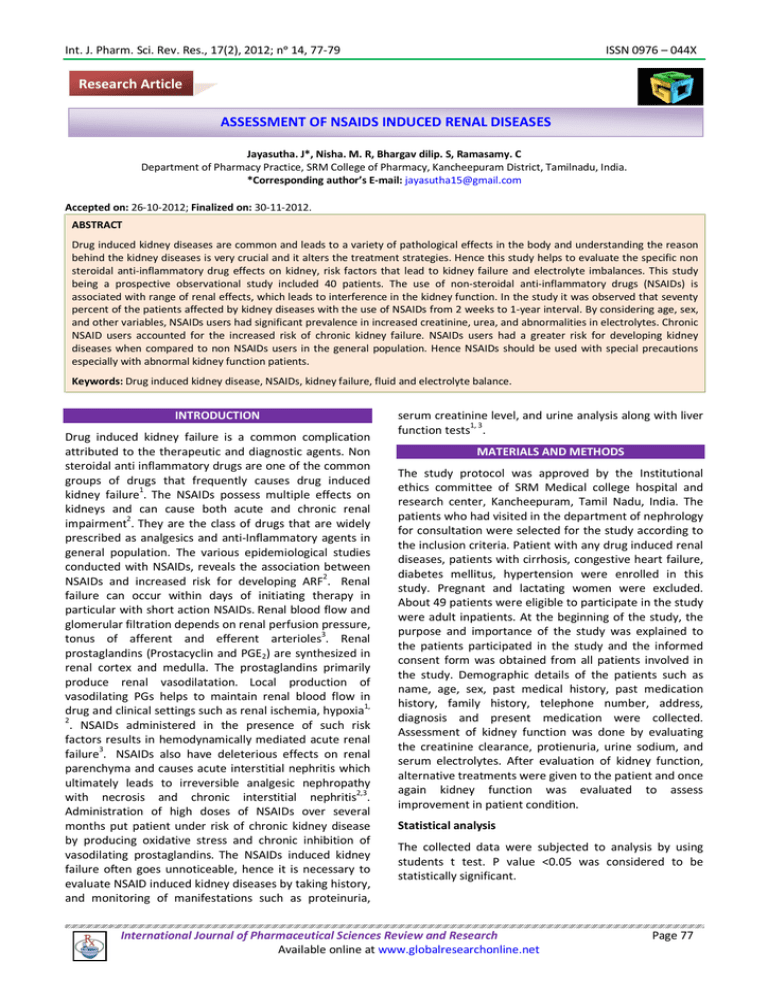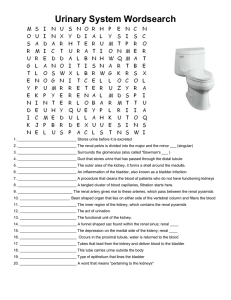Document 13308942
advertisement

Int. J. Pharm. Sci. Rev. Res., 17(2), 2012; nᵒ 14, 77-79 ISSN 0976 – 044X Research Article ASSESSMENT OF NSAIDS INDUCED RENAL DISEASES Jayasutha. J*, Nisha. M. R, Bhargav dilip. S, Ramasamy. C Department of Pharmacy Practice, SRM College of Pharmacy, Kancheepuram District, Tamilnadu, India. *Corresponding author’s E-mail: jayasutha15@gmail.com Accepted on: 26-10-2012; Finalized on: 30-11-2012. ABSTRACT Drug induced kidney diseases are common and leads to a variety of pathological effects in the body and understanding the reason behind the kidney diseases is very crucial and it alters the treatment strategies. Hence this study helps to evaluate the specific non steroidal anti-inflammatory drug effects on kidney, risk factors that lead to kidney failure and electrolyte imbalances. This study being a prospective observational study included 40 patients. The use of non-steroidal anti-inflammatory drugs (NSAIDs) is associated with range of renal effects, which leads to interference in the kidney function. In the study it was observed that seventy percent of the patients affected by kidney diseases with the use of NSAIDs from 2 weeks to 1-year interval. By considering age, sex, and other variables, NSAIDs users had significant prevalence in increased creatinine, urea, and abnormalities in electrolytes. Chronic NSAID users accounted for the increased risk of chronic kidney failure. NSAIDs users had a greater risk for developing kidney diseases when compared to non NSAIDs users in the general population. Hence NSAIDs should be used with special precautions especially with abnormal kidney function patients. Keywords: Drug induced kidney disease, NSAIDs, kidney failure, fluid and electrolyte balance. INTRODUCTION Drug induced kidney failure is a common complication attributed to the therapeutic and diagnostic agents. Non steroidal anti inflammatory drugs are one of the common groups of drugs that frequently causes drug induced kidney failure1. The NSAIDs possess multiple effects on kidneys and can cause both acute and chronic renal impairment2. They are the class of drugs that are widely prescribed as analgesics and anti-Inflammatory agents in general population. The various epidemiological studies conducted with NSAIDs, reveals the association between NSAIDs and increased risk for developing ARF2. Renal failure can occur within days of initiating therapy in particular with short action NSAIDs. Renal blood flow and glomerular filtration depends on renal perfusion pressure, tonus of afferent and efferent arterioles3. Renal prostaglandins (Prostacyclin and PGE2) are synthesized in renal cortex and medulla. The prostaglandins primarily produce renal vasodilatation. Local production of vasodilating PGs helps to maintain renal blood flow in 1, drug and clinical settings such as renal ischemia, hypoxia 2 . NSAIDs administered in the presence of such risk factors results in hemodynamically mediated acute renal failure3. NSAIDs also have deleterious effects on renal parenchyma and causes acute interstitial nephritis which ultimately leads to irreversible analgesic nephropathy with necrosis and chronic interstitial nephritis2,3. Administration of high doses of NSAIDs over several months put patient under risk of chronic kidney disease by producing oxidative stress and chronic inhibition of vasodilating prostaglandins. The NSAIDs induced kidney failure often goes unnoticeable, hence it is necessary to evaluate NSAID induced kidney diseases by taking history, and monitoring of manifestations such as proteinuria, serum creatinine level, and urine analysis along with liver function tests1, 3. MATERIALS AND METHODS The study protocol was approved by the Institutional ethics committee of SRM Medical college hospital and research center, Kancheepuram, Tamil Nadu, India. The patients who had visited in the department of nephrology for consultation were selected for the study according to the inclusion criteria. Patient with any drug induced renal diseases, patients with cirrhosis, congestive heart failure, diabetes mellitus, hypertension were enrolled in this study. Pregnant and lactating women were excluded. About 49 patients were eligible to participate in the study were adult inpatients. At the beginning of the study, the purpose and importance of the study was explained to the patients participated in the study and the informed consent form was obtained from all patients involved in the study. Demographic details of the patients such as name, age, sex, past medical history, past medication history, family history, telephone number, address, diagnosis and present medication were collected. Assessment of kidney function was done by evaluating the creatinine clearance, protienuria, urine sodium, and serum electrolytes. After evaluation of kidney function, alternative treatments were given to the patient and once again kidney function was evaluated to assess improvement in patient condition. Statistical analysis The collected data were subjected to analysis by using students t test. P value <0.05 was considered to be statistically significant. International Journal of Pharmaceutical Sciences Review and Research Available online at www.globalresearchonline.net Page 77 Int. J. Pharm. Sci. Rev. Res., 17(2), 2012; nᵒ 14, 77-79 ISSN 0976 – 044X RESULTS AND DISCUSSION A total of 40 patients meeting the study criteria were enrolled into the study. The data were analyzed for all 40 patients of which 52.5% were female and 47.5% were male. Table 1 shows age distribution of 40 patients. age and diabetes mellitus were the causing factor for drug induced renal insufficiency (15 patients). Hypertension in 5 patients, dehydration and infection episode in 2 patients were the other causes of drug induced renal diseases. Table 2: Risk factors Table 1: Age wise distribution Age (years) No of patients (n=40) % of patients 20-29 4 10.0 30 – 39 7 17.5 40 – 49 11 27.5 50 -59 12 30.0 > 60 6 15.0 Total 40 100.0 No of patients (n = 40) Risk Factors It is not surprising that age greater than 60 yr is associated with a high rate of adverse effects due to NSAIDs if one considers that almost 40% of all NSAIDs are prescribed for elderly patients and that renal function decreases markedly with age even in healthy individuals6. Table 2 shows the details of risk factors associated with drug induced renal diseases. Previous history of cirrhosis, congestive heart failure, diabetes mellitus, hypertension were also associated with renal diseases. The most common cause of drug induced renal diseases were alcoholism which resulted in 12 patients (30%). Elderly % of patients Dehydration 2 5.0 Alcoholism 12 30.0 Elderly age 6 15.0 Infection 2 5.0 Hypertension 5 12.5 Diabetes mellitus 6 15 Nil 7 17.5 Total 40 100 Drugs were the common precipitating agents (Table 3). Of the 40 episodes caused by drugs, 9 were due to diclofenac, 6 were due to aceclofenac, 10 were due to ibuprofen, 9 were due to paracetamol and 6 were due to aspirin. Reversible renal insufficiency has been reported in association with all NSAIDs. The renal complications may occur in the presence or the absence of nephrotic syndrome and marked proteinuria3. Table 3: Drugs associated with drug induced renal diseases Drugs Diseases No of patients (n=40) % of patients Diclofenac Acute kidney injury 9 22.5 Diuretics, dialysis Aceclofenac Acute kidney injury 6 15 Diuretics, dialysis Ibuprofen Chronic kidney disease 10 25 Diuretics, dialysis Paracetamol Acute kidney injury 9 22.5 Aspirin Acute kidney injury 6 15 40 100.0 Total Evaluation of laboratory measurements for clinical assessment of renal diseases The serum creatinine base and review values were measured. The mean serum creatinine base and review levels were 5.37±2.965mg/dl and 3.71±2.196 mg/dl respectively. Mean creatinine levels after the treatment were significantly lower when compared with the levels before the treatment. The urea base and review values were measured. The mean urea base and review levels were 115.68±68.913 mg/dl and 86.18±53.451 mg/dl respectively. Mean urea levels after the treatment were significantly lower when compared with the levels before the treatment. The concentrations of sodium, potassium, calcium and phosphates levels were measured. After the treatment alternative, electrolytes levels were statistically significant (P<0.0001). The most frequent effect is Alternative therapy Diuretics Diuretics, dialysis interference with electrolyte homoeostasis, as reflected in retention of fluid and sodium, hyperkalemia6. Risks decreased after the NSAID treatment was discontinued. The risk was slightly greater with long term duration and high doses of NSAIDs4. NSAIDs rank second to aminoglycosides as the most common cause of nephrotoxic acute renal failure. Besides producing a reversible renal failure, NSAIDs are known to cause acute interstitial nephritis with haematuria, proteinuria and flank pain5. CONCLUSION NSAID users had a greater risk of developing kidney diseases and it should be used rationally and with special precautions especially with abnormal kidney function patients. International Journal of Pharmaceutical Sciences Review and Research Available online at www.globalresearchonline.net Page 78 Int. J. Pharm. Sci. Rev. Res., 17(2), 2012; nᵒ 14, 77-79 REFERENCES 1. 2. 3. Joseph.T.Dipro, Robert.L.talbert, Gary.C.Yee, Gary.R.Matzke, Barbara.G.Wells, L Michael Posey, th Pharmacotherapy-A Pathophysiologic Approach, 7 edition. McGraw-Hill Companies, United States of America, 2008, 750-804. Consuelo Huerta, Jordi Castellsague, Cristina VarasLorenzo, Luis Alberto García Rodríguez, Nonsteroidal AntiInflammatory Drugs and Risk of ARF in the General Population, American Journal of Kidney Disease, 45, 2005, 531-539. ISSN 0976 – 044X 4. Evans JMM, McGregor E, McMahon AD, Non-steroidal antiinflammatory drugs and hospitalization for acute renal failure, Q J Med 88, 1995, 551-557. 5. Ejaz P, Bhojani K, Joshi VR, NSAIDs and Kidney, JAPI, 52, 2004, 632-640. 6. Delmas PD, Non-steroidal anti-inflammatory drugs and renal function, Br J Rheumatol, 34, 1995, S25-S28. 7. Epstein M, Non-steroidal anti-inflammatory drugs and the continuum of renal dysfunction, J Hypertens 20(6),S17S23, 2002. Mladen Knotek, Drug-Induced Kidney Injury, The journal of the international federation of clinical chemistry and laboratory medicine, 20(1), 2009. ******************** International Journal of Pharmaceutical Sciences Review and Research Available online at www.globalresearchonline.net Page 79





